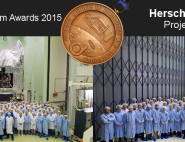Organisation
ESA had oversight responsibility for the Herschel mission. France took part in the project through its participation in ESA’s mandatory Science Programme. CNES’s role was to monitor and fund every contribution from French laboratories.
Under ESA supervision, Thales Alenia Space (TAS) was prime contractor on both the Herschel and Plank missions. As Herschel’s industrial architect, TAS provided:
- the spacecraft bus,
- satellite engineering,
- satellite assembly, integration and testing (AIT),
- and oversaw the launch campaign.
The Herschel satellite was built by a consortium in which Astrium (from Friedrichshafen, Germany) and Alenia (from Turin, Italy) also took part. Various consortiums also developed its three instruments.
- The SPIRE team was led by M. Griffin, Cardiff University, Wales
- the PACS group was supervised by A. Poglitsch, MPE, Garching, Germany
- and the HIFI team was headed by Th. de Graauw, SRON, Groningen, The Netherlands.
The French laboratories took part in developing the three instruments:
- SPIRE:
- CEA/DAPNIA (now IRFU) developed the DRCU
- LAM developed the Fourrier Transform Spectrometer mechanism, the MCU electronics in charge of controlling the mechanism, as well as spectrometer and photometer optics.
- PACS:


